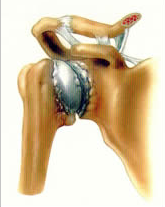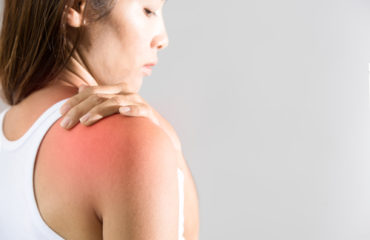Many people worldwide suffer from some variation of arthritis, which is an inflammation of the joints. One of the most common spots for an individual to develop this inflammation is the shoulder, leading to stiffness, decreased range of motion, and general pain. Arthritis within the  shoulder has no direct cure, but has several available treatment options for you to choose from.
shoulder has no direct cure, but has several available treatment options for you to choose from.
The shoulder of the body consists of an intersection of three bones: The humerus, the scapula, and the clavicle. The humerus head ends in a ball that fits into a rounded socket formed by the scapula. This ball and joint socket is held together by muscles and tendons, which work to provide the arm with its range of motion.
This entire structure is referred to as the rotator cuff of the body and it is within this ball and socket joint that many people develop their case of arthritis. There are two areas that typically become inflamed. These are the glenohumeral joint, where the head of the humerus sockets into the scapula, and the acromioclavicular joint where the shoulder blade meets the clavicle.
Shoulder Arthritis Types
Due to the complexity of the joint, there are numerous areas that arthritis can develop.
- Rheumatoid Arthritis (RA) – This occurs as the result of an autoimmune disease and is a chronic attack of multiple joints, typically in a symmetrical pattern. This often
 causes swelling in the lining of the joints, leading to pain and stiffness due to difficulty of movement. There is also a chance of the immune system directly attacking the musculature of the joint leading to a decreased ability to reliably use the joint. RA has been known to affect both the AC and the glenohumeral with no particular favor to either.
causes swelling in the lining of the joints, leading to pain and stiffness due to difficulty of movement. There is also a chance of the immune system directly attacking the musculature of the joint leading to a decreased ability to reliably use the joint. RA has been known to affect both the AC and the glenohumeral with no particular favor to either. - Rotator Cuff Tear Arthropathy – This arthritis occurs due to general atrophy of the tendon after a tear has occurred. Often this is due to the inability of the tendon to keep the ball properly seated in the socket of the shoulder, leading to the bone rubbing against the surrounding muscle causing damage to the surface of the bones. This general decay in bone structure leads to the formation of arthritis.
- Osteoarthritis – also known simply as OA, this occurs as a result of a general degradation of the bone. This gradual destruction of cartilage leads a roughness, or fraying, developing that causes the space between bones to be reduced. This leads to the bones having the ability to touch, further leading to a grinding away at the surface of the bone. This causes the majority of the pain associated with osteoarthritis, and is known to typically occur more in the acromioclavicular area.
- Post-Traumatic Arthritis – This is a separate form of OA mentioned above that has occurred as a result of direct injury to the shoulder. This can often be the result of a bone fracture or a dislocation of the socket, and has the related pain and stiffness.
Treatment
If the pain and the inhibition of movement are severe enough, your shoulder specialist in Phoenix may suggest you undergo surgery. There are a number of surgeries available dependent on what will benefit you most. One of the most commonly performed shoulder surgeries is to undergo an arthroscopy in which the Phoenix orthopedic surgeon inserts a small camera into the joint to examine it before readjusting the humerus to be properly seated. 
Often the attending orthopedic surgeon will clean out the shoulder joint of jagged cartilage as well, in an effort to prevent future degradation. In more severe cases, it may be suggested to undergo a shoulder replacement to place prosthetics in the shoulder to replace bone that has been damaged beyond repair.
Traditional shoulder replacement works well, however, one of the newer methods of shoulder replacements are the reverse option. This helps with functional recovery of the shoulder, especially when the rotator cuff is insufficient to help with movement.
Many shoulder surgeries require a lengthy period of recovery, therapy, and rehabilitation. Depending on the exact procedure you underwent, you can expect to have a full recovery of your shoulder within 6 to 8 weeks.

 causes swelling in the lining of the joints, leading to pain and stiffness due to difficulty of movement. There is also a chance of the immune system directly attacking the musculature of the joint leading to a decreased ability to reliably use the joint. RA has been known to affect both the AC and the glenohumeral with no particular favor to either.
causes swelling in the lining of the joints, leading to pain and stiffness due to difficulty of movement. There is also a chance of the immune system directly attacking the musculature of the joint leading to a decreased ability to reliably use the joint. RA has been known to affect both the AC and the glenohumeral with no particular favor to either.

